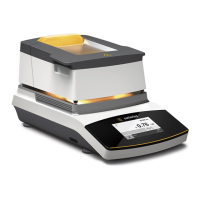The proportion of the IR rays which does not heat the sample is either reflected on
the surface of the sample or penetrates the sample unimpeded.
The color and surface properties of the sample significantly influence how effective
the heating process is. For example, dark substances absorb IR rays better than
bright substances.
How the rays penetrate the sample depends on the permeability of the sample.
If the degree of light-transmitting capacity is low, the rays can penetrate only the
uppermost layers of the sample. The heat conductivity of the sample dictates the
degree to which the heat can be transmitted to the underlying layers. The higher
the conductivity, the faster and more uniformly the substance is heated.
The substance should be applied to the sample pan in a thin, even layer. A height
of approximately 2–5 mm for 5–15 g substance weight has proved to be ideal.
Otherwise, the sample will not be dried completely or the analysis time will be
unnecessarily extended, a crust/skin will form on the surface of the sample or the
sample will scorch, and the analysis results obtained will not be reproducible (and
hence cannot be used).
While preparing substances for measurement, no processes may be used that
generate heat. The heat generated may result in a loss of moisture prior to the
measurement.
Perform initial analysis of a new substance to test how the IR rays are absorbed by
the sample and converted into heat. A printout of the intermediate values of the
drying process provides information on this at an early stage.
Since introducing IR rays produces intensive energy input in the sample,
the temperature setting selected for infrared drying is usually lower than the
temperature setting used when working with a drying oven.
In many cases, the fully automatic switch-off mode will meet your requirements.
If the final result is higher or lower than expected, try varying the temperature
setting before resorting to a different switch-off criterion.
When analyzing the samples that lose their moisture only very slowly or when
operating a cold moisture analyzer, the fully automatic mode may end the drying
routine too early since no analyzable progress in the drying routine can be
detected. In this case, preheat the moisture analyzer for two to three minutes
before starting the drying routine, or select a different switch-off criterion.
The Application Guide for the Sartorius Moisture Analyzer provides you with
important information on the use of your moisture analyzer.
14
Operating Instructions Moisture Analyzer MA160
Basic Principles

